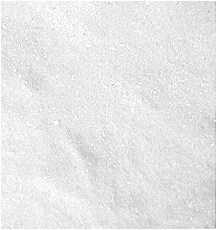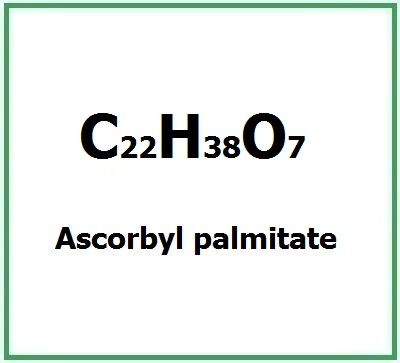Ascorbyl palmitate is an ester formed by L-ascorbic acid, of which it is a lipophilic derivative, and palmitic acid with relative formation of Vitamin C and is fat-soluble in water.
It appears in the form of a white powder.

It has emulsifying properties with high hydrophilic-lipophilic balance and performs activities as a coemulsifying and antioxidant agent in drugs, vitamins and cosmetics.
It is labeled with the number E304 in the list of food additives with antioxidant function.
Liposoluble, it has all the characteristics of vitamin C, it is able to be stored in the lipid cell membrane until the body is able to use it.
Antioxidant, improves the activity of the cells of the immune system as it gives oxygen to the radicals produced in the oxidation process by inhibiting their formation.
In a search of scientific studies, I found this one study that finds Ascorbyl palmitate dangerous at high concentrations: synthetic food additives such as Ascorbyl palmitate are commonly used as antioxidants in the food industry. In this study, the cytotoxicity and genotoxicity effect of this chemical compound on human umbilical vein endothelial cells was evaluated. The study concluded that since the results indicated that Ascorbyl palmitate has the ability to induce apoptosis in human umbilical vein endothelial cells it would be better to do a thorough analysis on its wide application in the food industry. At high concentration it can be considered as cytogenotoxic agent. (1).
However, EFSA (European Food Safety Authority) considers the component safe and not subject to maximum daily dose restrictions (2) and confirmed the opinion in 2020 (3).
The scientific literature as a whole considers Ascorbyl palmitate an inhibitor of cell proliferation and DNA synthesis in many types of cancer (4) although, despite having a higher stability, its bioavailability and therapeutic effect are low due to its lipophilicity and low release capacity (5).
It is also able to self-assemble into a hydrogel in vitro (6) therefore useful for the administration of drugs aimed at counteracting inflammation.
Cosmetics
Antioxidant agent. Ingredient that counteracts oxidative stress and prevents cell damage. Free radicals, pathological inflammatory processes, reactive nitrogen species and reactive oxygen species are responsible for the ageing process and many diseases caused by oxidation.
Fragrance. It plays a decisive and important role in the formulation of cosmetic products as it provides the possibility of enhancing, masking or adding fragrance to the final product, increasing its marketability. The consumer always expects to find a pleasant or distinctive scent in a cosmetic product.
Ascorbyl palmitate studies
| Appearance | White powder |
Boiling Point
| 512.7±50.0°C at 760 mmHg |
Melting Point
| 115-118°C(lit.) |
Flash Point
| 164.4±23.6°C |
| Density | 1.2±0.1 g/cm3 |
| PSA | 113.29000 |
| LogP | 6.07 |
| Refraction Index | 1.521 |
Vapor Pressure
| 0.0±3.0 mmHg at 25°C |
| Storage | +15°C to +25°C |
| Safety |  |
- Molecular Formula C22H38O7
- Molecular Weight 414.539 g/mol
- Exact Mass 414.261749
- UNII: QN83US2B0N
- CAS: 137-66-6 120398-58-5 162872-43-7 57233-83-7 924964-24-9 1184913-60-7 2095286-71-6 948551-42-6
- EC Number: 205-305-4
- PubChem Substance ID 329749066
- MDL number MFCD00005377
- Beilstein Registry Number 96552
- DSSTox Substance ID DTXSID3041611
- IUPAC [(2S)-2-[(2R)-3,4-dihydroxy-5-oxo-2H-furan-2-yl]-2-hydroxyethyl] hexadecanoate
- InChI=1S/C22H38O7/c1-2-3-4-5-6-7-8-9-10-11-12-13-14-15-18(24)28-16-17(23)21-19(25)20(26)22(27)29-21/h17,21,23,25-26H,2-16H2,1H3/t17-,21+/m0/s1
- InChl Key QAQJMLQRFWZOBN-LAUBAEHRSA-N
- SMILES CCCCCCCCCCCCCCCC(=O)OCC(C1C(=C(C(=O)O1)O)O)O
- ChEBI 140768
- RXCUI 1088438
- RTECS CI7671040
Siynonyms:
- L-Ascorbyl 6-palmitate
- Ascorbyl monopalmitate
- Ascorbyl palmitate [NF]
- 6-O-Palmitoyl-L-ascorbic acid
- L-Ascorbic acid 6-hexadecanoate
- 6-Palmitoyl-L-ascorbic acid6-O-Palmitoyl ascorbate
- Ascorbyl palmitate (NF)
- Ascorbic acid 6-palmitate
- Ascorbyl palmitate (VAN)
- L(+)-Ascorbyl palmitate, specified according to requirements of USP/Ph.Eur.
- 2-((2R)-3,4-dihydroxy-5-oxo(2-2-hydrofuryl))(2S)-2-hydroxyethyl hexadecanoate
- Ascorbic palmitate
- L-Ascorbyl palmitate
- (S)-2-((R)-3,4-Dihydroxy-5-oxo-2,5-dihydrofuran-2-yl)-2-hydroxyethyl palmitate
References___________________________________________________________________
(1) Sohrabi Y, Mohammadzadeh-Aghdash H, Baghbani E, Dehghan P, Ezzati Nazhad Dolatabadi J. Cytotoxicity and Genotoxicity Assessment of Ascorbyl Palmitate (AP) Food Additive. Adv Pharm Bull. 2018 Jun;8(2):341-346. doi: 10.15171/apb.2018.039.
(2) EFSA Journal 2013;11(2):3104
(3) EFSA Panel on Food Additives and Flavourings (FAF), Younes M, Aquilina G, Castle L, Engel KH, Fowler P, Frutos Fernandez MJ, Fürst P, Gürtler R, Husøy T, Manco M, Mennes W, Moldeus P, Passamonti S, Shah R, Waalkens-Berendsen I, Wölfle D, Wright M, Dusemund B, Mortensen A, Turck D, Barmaz S, Smeraldi C, Tard A, Vianello G, Rincon AM, Gundert-Remy U. Opinion on the re-evaluation of ascorbyl palmitate (E 304i) as a food additive in foods for infants below 16 weeks of age and the follow-up of its re-evaluation as a food additive for uses in foods for all population groups. EFSA J. 2020 Jun 30;18(6):e06153. doi: 10.2903/j.efsa.2020.6153.
(4) Kalaycioglu GD. Preparation of magnetic nanoparticle integrated nanostructured lipid carriers for controlled delivery of ascorbyl palmitate. MethodsX. 2020 Nov 17;7:101147. doi: 10.1016/j.mex.2020.101147.
(5) Shi S, Yang L, Yao Q, Li X, Ming Y, Zhao Y. Ascorbic Palmitate as a Bifunctional Drug and Nanocarrier of Paclitaxel for Synergistic Anti-Tumor Therapy. J Biomed Nanotechnol. 2018 Sep 1;14(9):1601-1612. doi: 10.1166/jbn.2018.2615.
(6) Vemula PK, Boilard E, Syed A, Campbell NR, Muluneh M, Weitz DA, Lee DM, Karp JM. On-demand drug delivery from self-assembled nanofibrous gels: a new approach for treatment of proteolytic disease. J Biomed Mater Res A. 2011 May;97(2):103-10. doi: 10.1002/jbm.a.33020.
![]() Ascorbyl palmitate
Ascorbyl palmitate 







